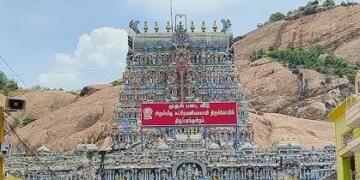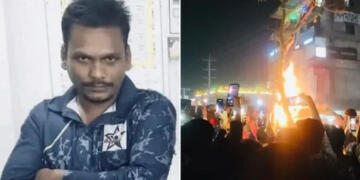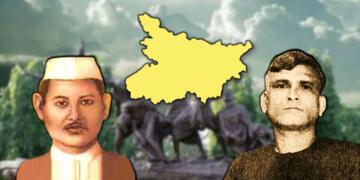Renowned English primatologist Jane Goodall used to believe that humans are primarily born good, and it is social institutions like religion, state, and caste among others that make them corrupt. Then her interest took her towards the jungle. She spent years observing chimps, a type of animal holding similar DNA to humans. Chimps are just a few steps behind us in human evolution and observing their behaviour would give a deep insight into human nature. Goodall was shocked to find that chimps hold group warfare and in fact, are more brutal than humans in their methods.
Hindu Samaj is coming to terms with reality
Recently, something on similar lines was realized by Hindu Samaj. Various individuals have been killed in the name of group protection by competing tribes. The most recent was the ghastly murder of Kanhaiya Lal in the Udaipur district of Rajasthan. Kanhaiya was busy earning bread and butter for his family. Two Islamists came posing as customers and just when Kanhaiya was too involved in his work, they took out their sharp knives and slashed his throat. Kanhaiya’s head was cut off from his body and later they went to make a video boasting about the killing.
However, the way in which Kanhaiya died needs more attention from Hindus than the cause of his death. The cause is permanent and is not expected to wither away anytime soon in foreseeable future. Kanhaiya Lal died literally requesting them not to kill him. “Mere 2 bacche hain” (I have 2 kids) are believed to be his last words. By stating this, he is making a last humanitarian cry for help. It is not a criticism as it was his last option. But the bigger question is why this appeal came off only within a few seconds of the first blood.
Unfortunately, Kanhaiya could not hold up for long and we all know the reason. He was not much physically threatening to those Islamists. But unfortunately, there are millions of Hindus who won’t be able to tolerate a slightly milder version of such attacks. They are too cosy sitting in their comfortable homes, consuming food products designed to keep them hooked up to screens. For them, these incidents are few and far. If you interact with them, they will tell you that the Internet tends to magnify these killings and there is no imminent risk to their lives.
Tribal warfare is a feature, not a bug
Whether we want it to be true or not, the fact of the matter is that we humans are tribal. It is in our DNA to keep getting involved in conflict. When we were not members of modern society, we used to fight for territory and resources. Those points of conflict are still there, but religious conflict is another addition. Initially, religious conflicts were only a subset of conflict for resources, but as societies tasted prosperity, death in the name of religion continued, which tells us that religious conflicts are now a set of their own.
Especially in the last 2 millennia, it has become standard practice. The crusade between the troika of Christianity, Islam, and Judaism is a prime example of that. Due to Abrahamic waves in India, somehow Sanatan Dharma got entangled as well. Sanatanis became Kafirs and pagans and that is how they became born enemies for at least two of the above three. Over the last 1300 years, Hindu Samaj did offer resistance and they were quite successful, though failure is also a part of the resistance story.
Our moral fabric has been systematically weakened
But the entry of Mohan Das Karamchand Gandhi worsened the problem for Hindus. He introduced a concept called what I term “absolute non-violence” in the wake of oppression. Gandhi told Indians and especially Hindus that even if someone hits you in the cheek, you should not hit back, instead, you should forward your other cheek. The reasoning was that after a few rounds of punching you in the face, the person will feel embarrassed and stop hitting you out of moral shame.
To give moral credence to this theory, various historical shlokas were changed out of context. For example, “अहिंसा परमो धर्मः धर्म हिंसा तथैव च: l” was misquoted to gullible Hindus as “अहिंसा परमो धर्मः”. Similarly, the concept of “Vasudhaiv Kutumbakam” was promoted to the peril of “Veer Bhogya Vasundhara.” Apart from Hindus’ own neglect of their Shashtras, the dishonesty by public intellectuals was the main reason behind it. Very few people in the public domain called for violence as a retort to violence by the British.
Things did not change after independence
After independence, Gandhian thought prevailed, which further weakened the moral credence of society. People do follow non-violence, but society ended up creating benefits for those who are more inclined to commit violence. The rest of the damage was done by incessant consumerism introduced by LPG reforms in 1991. Hindus had already started to drop the idea of reading Shastras, they started ditching the use of Sastras as well. Over the next 25 years, Hindus focussed on earning bread and butter and left Dharmic causes to die on their own.
Challenge for Hindus
Simultaneously, Islamists were gaining traction. The Mujahideen of Afghanistan had now percolated to Kashmir and by extension, their network had expanded all over India. ISI operatives in India were a common sight in the pre-2014 era. After that ISIS fanaticism started to spread, but thankfully due to a nationalistic government at the helm of affairs, penetration was limited to regions like Kerala.
But the idea made a foothold and Islamists became busy radicalizing youth. Hindu Samaj on the other hand was following the old order rulebook, relying on the state to protect them in times of need. But the danger has gotten so big that the chances of the state being able to protect Hindus has got diminished. And they know it (Remember 15-minute ke liye Police hata lo? Or Asaduddin Owaisi’s threat to UP Police?)
So, what is the option? It is only self-defence. There are two ways to do it. The first one is through using arms while the second one is by strengthening your own body. An amalgamation of both strengths will be a much better third option.
Need for self-defence
Arms training is difficult to acquire. If we watch our environment closely, there are plenty of objects which can thrash an approaching predator in a fraction of seconds. This could be anything, a rod, or a truck axle among others.
The simplest of them and easiest to acquire is latth or lathi (as they say in some places). The shape, size in which it is available, and methods in which it can be operated make for in-built flexibility. A lathi is generally a few feet tall and you hold it by the centre. The two diameters of the imaginary circle rotate with your hand. Learning how to properly rotate it in four directions can keep the enemy at bay. No one wants to risk getting hit in their head, no matter how big the opponent is. Similarly, operating it by holding it from one end is more dangerous for the attacker. The sphere of fear gets concentrated on one person, the attacker.
Get off your beanbag
But things can go haywire in combat. That is where a strong body acts as a base upon which we can rely on. A strong body built by lifting weights can tolerate much more thrust than the one destroyed by a caffeinated body and mozallera pizza. There is a severe need to detoxify the body before the process of strengthening it even begins.
After the first stage is complete, one needs to start running and build up stamina for further stages. Additionally, having a blood circulation system built by running can assist when you are cornered in an isolated location by a mob. In fact, it is the last option to save in those circumstances. If somehow one can manage to run 1km, more than 99 per cent of the mob will dissipate, simply because they don’t have the stamina. Moreover, the new location could be far safer.
Need to learn endurance training and other techniques of self-defence
It takes over a week for a weakened body to build momentum by running. During the week, one should try to do push-ups and other forms of endurance-building exercises. After a weak, a fixed time should be allotted for endurance training. It is a waste of the human body if one can’t even lift his/her own body 5 consecutive times. It is a great advantage for humans to lift other sapiens like them. Frankly, it is the greatest strength, because that means that your near and dear ones can rely on you in times of urgency. It is what makes the Armed Forces so reliable unit of any state.
Last, but not least, there are some shortcut techniques you can learn as well. For one, you can build your hand speed by practising it daily. Even if you do not have strength, your speed will generate enough momentum to punch back at someone with ferocious intensity. This technique is widely known and even used in sports like cricket. Cricketers like Brendon McCullum, and James Taylor among others use bat speed to generate force to pummel the ball beyond the boundary line. Even 5 minutes of daily practice will take make your hand speed cut above the rest.
Time for the revival of Sastra vidya
In case you are attacked, the agile body will help you in ducking and saving yourself from threat. Other techniques like locking the enemy’s key organs such as hand, leg, neck, and shoulders among others also work like wonders in such crisis such as the one faced by poor Kanhaiya Lal.
There is a dire need in our country for reviving our ancient Hindu heritage along with our culture. In ancient times, our society was as tolerant as today. But that tolerance came on the back of strength and not as moral posturing. The enemy knew that they are at the mercy of the strong and did not take it for granted. Unlike today, weakness was not a social virtue to live by. It needs to come back, and it will start only with Sastra Vidya.
Support TFI:
Support us to strengthen the ‘Right’ ideology of cultural nationalism by purchasing best quality garments from TFI-STORE.COM


































